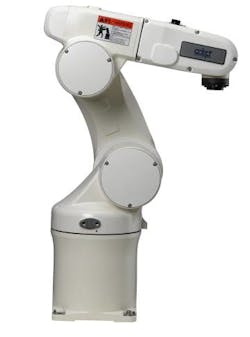In response to changing market conditions, Adept Technology Inc., a Livermore, Calif.-based robotics vendor, is rolling out a new line of six-axis articulated robots designed for precision assembly applications.
The new line, called the AdeptViper robot family, is already at work in the field. Adept says it recently completed delivery of 60 AdeptViper s650 robots to a global cell phone contract manufacturer. The shipment was the first in a multi-year program that is expected to result in the sale and delivery of more than 400 AdeptViper s650 robots during the course of the contract, the company says.
“One of the trends that we’re seeing in the telecom market is a move toward six-axis robots on the assembly lines,” said John Dulchinos, Adept vice president and general manager of robotics, in a recent interview prior to the April 27 AdeptViper announcement. “Five or six years ago, we would have deployed a line built with all [four-axis] SCARA robots (for selective compliance articulated robot arm) and/or Cartesian robots, and maybe just one or two six-axis robots.”
The move toward six-axis arms by cell phone makers is driven by a need for more flexibility to meet a requirement for shorter product runs, Dulchinos said. “In the cell phone market 10 years ago, they produced maybe 50 different models of phones, and that covered the entire global requirement for the market. Today, it’s ten times that, and there are hundreds of different models, so phone manufacturers need the flexibility to be able to introduce new products and to switch products on a regular basis.”
Ultimate flexibility
Cell phone manufacturers, like other users of assembly robots, are also more frequently integrating machine vision into robot applications, Dulchinos added. “The ultimate in flexibility is an articulated arm that gives you six full degrees of freedom, vision to be able to find an object and adapt to the environment, and vision-based feeding to eliminate fixtures, hard tooling, and feeding systems that are dedicated to parts.”
In its AdeptViper announcement, Adept quoted market figures in support of the trends. Recent statistics published by the VDMA (for Verband Deutscher Maschinen-und Anlagenbau—the German Engineering Federation) and substantiated by information from the U.S. Robotic Industries Association (RIA, www.roboticsonline.com), Ann Arbor, Mich., indicate that the articulated, six-axis marketplace is five times larger than the traditional SCARA, or four-axis market.
“Precision manufacturing is moving to shorter runs of multiple products vs. the traditional production line. Adept has seen this in all consumer products,” commented Rob Bucher, Adept chairman and chief executive officer. “The AdeptViper robots, in combination with our other high precisions robots, controllers and vision, such as our Adept Cobra SCARA robots and recently introduced iSight Vision package, has been defined to best serve this growing trend of Adept’s markets.”
Adept Viper robots are available in two models, the s650 and the s850, designed for either table-mounting or ceiling-mounting, and have a five kilogram payload.

